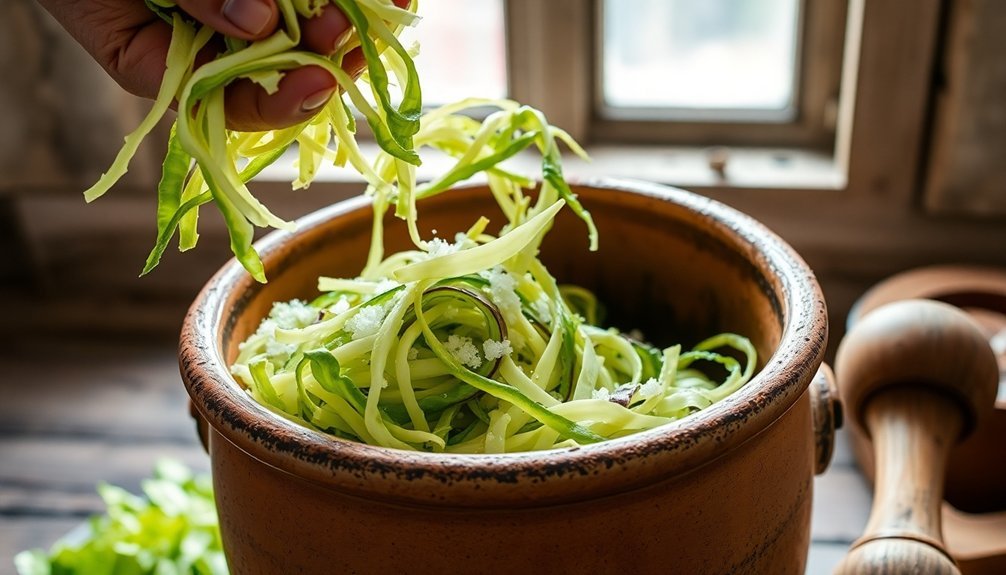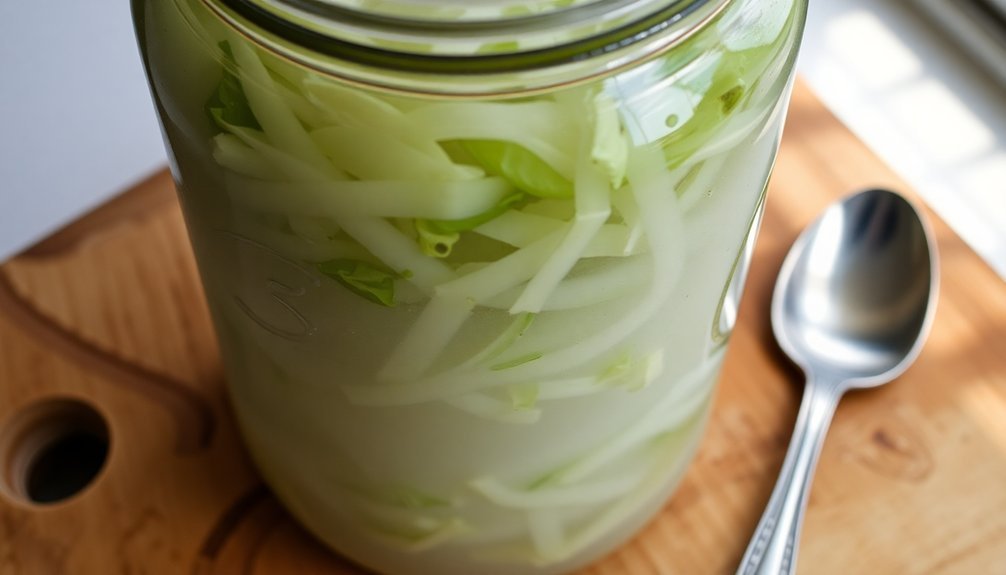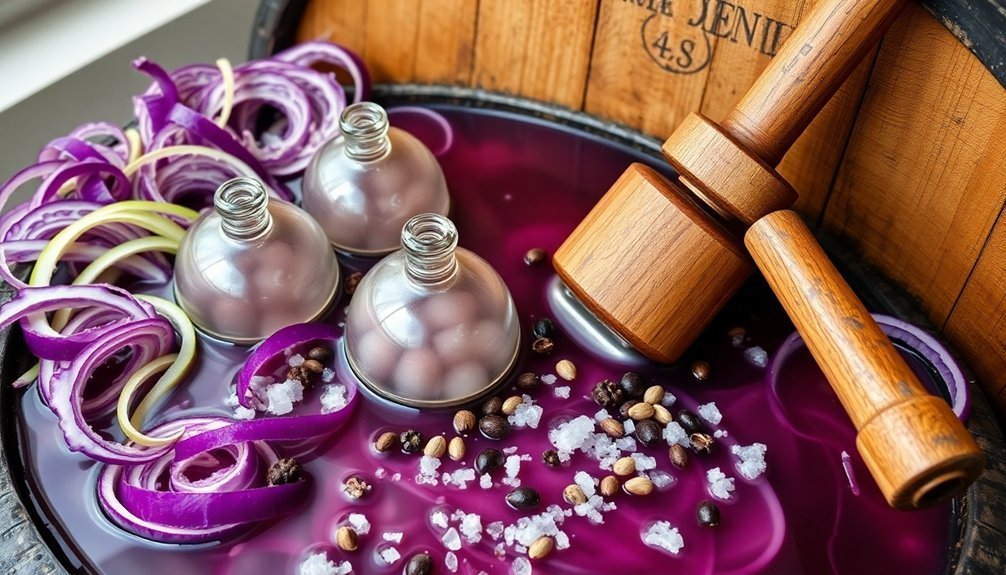Five proven methods can help you create perfectly fermented cabbage at home. The traditional salt method uses a 2.25-2.5% salt concentration for classic results, while dry brining lets the cabbage create its own natural brine through salt extraction. You'll find whey-based fermentation speeds up the process with added probiotics, and the root vegetable companion method introduces complex flavors through complementary ingredients. The spiced wild fermentation process allows for creative additions while maintaining traditional techniques. Each method offers unique benefits and flavors, with endless possibilities for customization waiting to be explored.
The Traditional Salt Method

For generations, home cooks have relied on salt fermentation to transform fresh cabbage into tangy, probiotic-rich sauerkraut.
You'll start by discarding the outer leaves and rinsing your cabbage heads under cold water. Quarter the heads, remove the cores, and shred the leaves to about a quarter-inch thickness. You can use either green or purple cabbage varieties.
The salt ratio is essential for successful fermentation. You'll need 3-3.5 tablespoons of canning or pickling salt for every 5 pounds of shredded cabbage, or aim for a 2.25-2.5% salt concentration by weight. Filtered water should be used throughout the process to ensure optimal fermentation results.
Don't use iodized salt, as it can inhibit fermentation. Mix the salt thoroughly into your shredded cabbage with clean hands, massaging it to release the natural juices.
Pack your salted cabbage firmly into a fermentation container, such as an earthenware crock or food-grade plastic pail. Leave 3-4 inches of headspace at the top.
You'll need to keep the cabbage submerged under its brine using clean weights or stones. Place your container in a spot that's 60-75°F, away from direct sunlight.
The fermentation process typically takes 3-14 days, with ideal flavor developing around day 10 or 11.
Dry Brine Fermentation
While the traditional salt method relies on a pre-mixed salt ratio, dry brine fermentation lets the cabbage create its own natural brine through salt extraction. You'll start by removing damaged outer leaves and shredding the cabbage thinly. Apply salt at 2% of the cabbage's weight, then massage it thoroughly until the leaves release their natural juices. The ideal temperature during fermentation should be 64 to 76°F for optimal results.
| Step | Action | Time |
|---|---|---|
| Prep | Remove outer leaves, shred cabbage | 10 min |
| Salt | Massage with 2% salt ratio | 5-10 min |
| Rest | Let cabbage release juices | 30-60 min |
| Pack | Transfer to jar, add weight | 5-10 min |
Pack your wilted cabbage tightly into a clean jar, leaving 1-3 inches of headspace. You'll need to guarantee all the shredded pieces stay submerged under the brine. Place a whole cabbage leaf on top as a barrier, then add your fermentation weight. If you notice the brine level's too low, don't add plain water – instead, create a salt solution using 1½ teaspoons of salt per cup of water. Your cabbage will need 3-4 weeks to ferment properly, though you can start taste-testing after 12 days.
Whey-Based Cabbage Fermentation

A splash of whey can revolutionize your cabbage fermentation process by introducing beneficial probiotic bacteria. You'll need 1-2 tablespoons of whey extracted from yogurt or kefir, along with sea salt and finely shredded cabbage. Using filtered water helps preserve the probiotic benefits since chlorine can harm the beneficial bacteria. This recipe typically yields 12 servings when prepared correctly.
Start by mixing your shredded cabbage with whey, salt, and optional flavorings like caraway seeds or juniper berries. Pound the mixture using a wooden pounder or meat hammer to release the natural juices, or knead it by hand until it becomes wet.
Pack the cabbage tightly into a wide-mouth mason jar, eliminating air pockets as you go. Ensure your cabbage stays submerged under at least an inch of liquid using weights or a brine-filled freezer bag.
Keep your ferment at room temperature, ideally between 64°F and 75°F, and leave an inch of headspace for expansion. You'll want to monitor the fermentation process for 7-14 days, tasting periodically until it reaches your desired tartness.
Once you're satisfied, transfer the jar to your refrigerator, where it'll keep for several months.
Root Vegetable Companion Method
Root vegetables add depth and complexity to your cabbage fermentation, creating a more diverse probiotic environment. When selecting root vegetables as companions, choose firm, unblemished specimens and scrub them thoroughly while leaving their beneficial skins intact.
You'll want to slice them thinly using a mandoline for consistent thickness and ideal bacterial penetration.
Start by mixing your brine using 1-3 tablespoons of salt per quart of non-chlorinated water. Layer the bottom of your wide-mouth jar with salt and herbs, then alternate layers of sliced cabbage and root vegetables, leaving 1-2 inches of headspace.
Use a kraut pounder to press down firmly on the vegetables, releasing their natural juices and eliminating air pockets.
Pour the brine over your vegetable mixture until it's completely submerged. You'll need to keep everything below the brine using clean weights or stones.
Store your fermentation vessel at 60-75°F, checking daily for pressure buildup. After 7-14 days, depending on your desired flavor profile, you'll have a complex, nutrient-rich ferment that's ready to be transferred to cold storage.
Spiced Wild Fermentation Process

Start your wild fermentation journey by thoroughly washing fresh cabbage and removing any questionable outer leaves.
Cut the cabbage into your preferred shape, whether thin slices or fat ribbons, using either a sharp knife or food processor.
Mix in your chosen spices, such as black peppercorns, coriander seeds, juniper berries, and caraway seeds, along with any additional ingredients like onions.
Sprinkle salt over your cabbage mixture using the ratio of 3½ tablespoons of canning salt per 5 pounds of cabbage.
Massage the mixture vigorously for about 5 minutes, then let it rest for 30-60 minutes until it releases its natural juices.
Continue squeezing and compressing until the cabbage becomes soft and sits in a pool of liquid.
Pack your seasoned cabbage tightly into a sterilized fermentation vessel, ensuring it's completely submerged under its liquid.
Use weights like clean stones or a water-filled jar to keep everything below the brine.
Leave headspace for expansion and cover loosely to allow gases to escape.
Let your creation ferment at room temperature (60-75°F) for 3-14 days, tasting periodically until you're satisfied with the flavor.
Store in the refrigerator for up to two months.
Frequently Asked Questions
Why Does My Sauerkraut Turn Pink or Develop a Brownish Color?
Your sauerkraut's pink or brown color comes from oxidation when it's exposed to air, yeast growth, or bacterial activity. You'll want to keep it fully submerged in brine to prevent these color changes.
Can I Use Leftover Brine From Previous Fermentation to Start New Batches?
Yes, you can reuse leftover brine from previous fermentations to kickstart new batches. It's rich in beneficial bacteria and works great as a starter culture. Just make sure the brine is fresh and free from contaminants.
What Causes My Sauerkraut to Become Slimy or Develop Unusual Textures?
Your sauerkraut's sliminess likely comes from too much air exposure, incorrect salt ratios, or improper temperature control. You'll want to keep cabbage submerged, use proper salt amounts, and maintain temperatures between 65-72°F.
Is Kahm Yeast on Top of My Fermented Cabbage Safe to Eat?
Yes, you can safely eat fermented cabbage with kahm yeast if the pH is below 4 and there's no mold present. While it's not ideal, you should skim off the yeast layer before eating.
Why Does My Sauerkraut Smell Like Rotten Eggs During Fermentation?
Don't worry – your sauerkraut smells like rotten eggs because it's producing hydrogen sulfide during fermentation. This is normal, caused by the sulfur in cabbage breaking down. It'll become less intense over time.
In Summary
You've now learned five reliable ways to transform fresh cabbage into probiotic-rich fermented goodness. Whether you've chosen the traditional salt method or opted for something more adventurous like wild fermentation, you'll find that each technique brings unique flavors and benefits. Don't be afraid to experiment with different spices and companion vegetables. With proper care and patience, you'll soon master the art of cabbage fermentation.





Leave a Reply